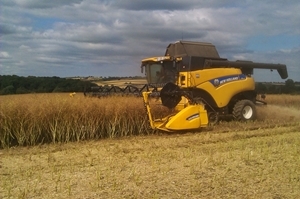By Amber Hopgood, Science Writer
 In the wake of COP26, climate change is something many of us are thinking about – and rightly so. Following COP21 in 2015, 195 nations adopted the Paris Climate Agreement and committed to try to keep the global average temperature no more than 2°C warmer than pre-industrial levels, aiming for less than 1.5°C of warming. This was rightly reinforced at COP26 with lots of emphasis on keeping global temperature increases as minimal as possible. You might then be asking, why 1.5°C?
In the wake of COP26, climate change is something many of us are thinking about – and rightly so. Following COP21 in 2015, 195 nations adopted the Paris Climate Agreement and committed to try to keep the global average temperature no more than 2°C warmer than pre-industrial levels, aiming for less than 1.5°C of warming. This was rightly reinforced at COP26 with lots of emphasis on keeping global temperature increases as minimal as possible. You might then be asking, why 1.5°C?
Although it doesn’t sound like much, the commitment to limit global warming to 1.5°C is important because every fraction of a degree of warming will result in the loss of life and the damage of habitats and livelihoods1. If left unchecked, the rate of global warming needed to hit 2°C will be too fast for lots of plants and animals to adapt and find suitable habitat. A study of 105,000 species found that if average global temperatures increase by 1.5°C, 6% of insects, 8% of plants, and 4% of vertebrates are likely to lose over half of their geographic range2 – near doubling if 2°C of warming occurs.
A top limit of 2°C of warming will also cause more problems for fisheries because of more intense ocean acidification and sea level rises, as well as putting maize, rice, wheat, and cereal crop production at high risk2,3. It is highly likely that livestock will be negatively affected, due to changes in food and water availability, more extreme weather, and spread of disease2. A 2021 study found that increases in agricultural productivity – for example due to better technology or stronger crop varieties - have fallen by 21% since 1961, which roughly equates to losing the last seven years of productivity improvements4.
None of this is particularly good news and goes to show that we should all be focused on limiting global warming as much as possible. At present, food systems make up a third of greenhouse gas emissions and play a large role in freshwater consumption and biodiversity decline across the world5,6. Agriculture occupies about 40% of global land6,7, so there is massive potential to make the most of all of this space and transition food systems to provide negative emissions, meaning that they soak up carbon and become what are called ‘carbon sinks’.
One of the biggest ways this can happen is through maintaining healthy ecosystems – we already know that biodiversity conservation is closely linked with food production, particularly as healthy biodiversity is needed to keep food systems productive and resilient. Even maintaining just 10% of land within agricultural landscapes for biodiversity can have large positive impacts for both the crops and local wildlife6.
This is something the Trust has championed for decades, and what our research teams and demonstration farms (such as the Allerton Project) spend lots of time researching to help guide agricultural policy – assessing the impacts of different kinds of farming on soil health, crop success, and biodiversity – looking to find the best ways to maximise ecological health in agricultural spaces.
As an organisation focused on finding practical, evidence-based solutions to help deal with challenges, it is great to see that COP26 brought fresh enthusiasm to ensuring we all work to develop science-based decision making and policy, and that there is a continuing commitment to be innovative.
References
- UK Government. (2021). COP26: The Negotiations Explained. Glasgow.
- Masson-Delmotte, V., Zhai, P., Pörtner, H.-O., Roberts, D., Skea, J., Shukla, P.R., Pirani, A., Moufouma-Okia, W., Péan, C., Pidcock, R., Connors, S., Matthews, J.B.R., Chen, Y., Zhou, X., Gomis, M.I., Lonnoy, E., Maycock, T., Tignor, M. & Waterfield, T. (2018). Global warming of 1.5°C: An IPCC Special Report on the impacts of global warming of 1.5°C above pre-industrial levels and related global greenhouse gas emission pathways, in the context of strengthening the global response to the threat of climate change,. Geneva, Switzerland.
- Subsidiary Body for Scientific and Technological Advice. (2015). Framework Convention on Climate Change: Report on the structured expert dialogue on the 2013–2015 review. Bonn.
- Ortiz-Bobea, A., Ault, T.R., Carrillo, C.M., Chambers, R.G. & Lobell, D.B. (2021). Anthropogenic climate change has slowed global agricultural productivity growth. Nature Climate Change, 11:306–312.
- Food and Agriculture Organization of the United Nations. (2013). Climate Smart Agriculture Sourcebook.
- Willett, W., Rockström, J., Loken, B., Springmann, M., Lang, T., Vermeulen, S., Garnett, T., Tilman, D., DeClerck, F., Wood, A., Jonell, M., Clark, M., Gordon, L.J., Fanzo, J., Hawkes, C., Zurayk, R., Rivera, J.A., De Vries, W., Majele Sibanda, L., Afshin, A., Chaudhary, A., Herrero, M., Agustina, R., Branca, F., Lartey, A., Fan, S., Crona, B., Fox, E., Bignet, V., Troell, M., Lindahl, T., Singh, S., Cornell, S.E., Srinath Reddy, K., Narain, S., Nishtar, S. & Murray, C.J.L. (2019). Food in the Anthropocene: the EAT-Lancet Commission on healthy diets from sustainable food systems. Lancet, 393:447–492.
- Foley, J.A., DeFries, R., Asner, G.P., Barford, C., Bonan, G., Carpenter, S.R., Chapin, F.S., Coe, M.T., Daily, G.C., Gibbs, H.K., Helkowski, J.H., Holloway, T., Howard, E.A., Kucharik, C.J., Monfreda, C., Patz, J.A., Prentice, I.C., Ramankutty, N. & Snyder, P.K. (2005). Global Consequences of Land Use. Science, 309:570–574.